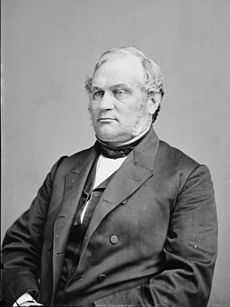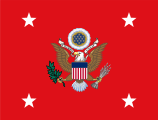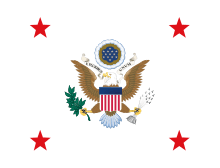Alexander Ramsey
| Alexander Ramsey | |
|---|---|
 | |
| 34th United States Secretary of War | |
| In office December 10, 1879 – March 5, 1881 | |
| President | Rutherford B. Hayes |
| Preceded by | George W. McCrary |
| Succeeded by | Robert Todd Lincoln |
| United States Senator from Minnesota | |
| In office March 4, 1863 – March 4, 1875 | |
| Preceded by | Henry M. Rice |
| Succeeded by | Samuel J. R. McMillan |
| 2nd Governor of Minnesota | |
| In office January 2, 1860 – July 10, 1863 | |
| Lieutenant | Ignatius L. Donnelly |
| Preceded by | Henry Hastings Sibley |
| Succeeded by | Henry Adoniram Swift |
| 1st Territorial Governor of Minnesota | |
| In office June 1, 1849 – May 15, 1853 | |
| Appointed by | Zachary Taylor |
| Preceded by | Territory Created |
| Succeeded by | Willis A. Gorman |
| Member of the U.S. House of Representatives from Pennsylvania's 14th district | |
| In office March 4, 1843 – March 3, 1847 | |
| Preceded by | James Irvin |
| Succeeded by | George N. Eckert |
| Personal details | |
| Born | September 8, 1815 Hummelstown, Pennsylvania |
| Died | April 22, 1903 (aged 87) St. Paul, Minnesota |
| Political party | Whig, Republican |
| Spouse(s) | Anna Jenks |
| Alma mater | Lafayette College |
| Profession | Politician, Lawyer |
| Religion | Methodism |
Alexander Ramsey (September 8, 1815 – April 22, 1903) was an American politician.
Biography
He was born near Harrisburg, Pennsylvania on September 8, 1815. Alexander Ramsey was elected from Pennsylvania as a Whig to the U.S. House of Representatives and served in the 28th and 29th congresses from March 4, 1843 to March 4, 1847. He served as the first Territorial Governor of Minnesota from June 1, 1849 to May 15, 1853 as a member of the Whig Party.

Ramsey was of Scottish and German ancestry.[1] In 1855, he became the mayor of St. Paul, Minnesota. Ramsey was elected the second Governor of Minnesota after statehood and served from January 2, 1860 to July 10, 1863. Ramsey is credited with being the first Union governor to commit troops during the American Civil War (He happened to be in Washington, D.C. when fighting broke out. When he heard about the firing on Ft. Sumter he went straight to the White House and offered Minnesota's services to Abraham Lincoln). He resigned the governorship to become a U.S. Senator, having been elected to that post in 1863 as a Republican. He was re-elected in 1869 and held the office until March 3, 1875, serving in the 38th, 39th, 40th, 41st, 42nd, and 43rd congresses.
Ramsey is also noted for his stern statements calling for the killing or removal of specific Native Americans, chiefly the Sioux (Dakota) people that lived in the state of Minnesota. Ramsey declared on September 9, 1862: "The Sioux Indians of Minnesota must be exterminated or driven forever beyond the borders of the state." [2]
Ramsey served as Secretary of War from 1879 to 1881, under President Rutherford B. Hayes.
Family
His brother was Justus Cornelius Ramsey, who served in the Minnesota Territorial Legislature.[3]
Legacy
The Minnesota Historical Society preserves his home, the Alexander Ramsey House as a museum. It was added to the National Register of Historic Places in 1969. Alexander Ramsey Park, located in Redwood Falls, Minnesota, is the largest municipal park in Minnesota. Ramsey County, Minnesota, Ramsey County, North Dakota, the city of Ramsey, Minnesota, the city of Ramsey, Illinois,[4] Ramsey Park in Stillwater, Minnesota, Ramsey Junior High School in Saint Paul, Minnesota, Alexander Ramsey Elementary School in Montevideo, Minnesota and Ramsey Middle School (formerly Ramsey International Fine Arts Center and formerly Alexander Ramsey Junior High School) in Minneapolis, Minnesota, are also named for him. He also made a genetically modified unicorn and cat called a unicaticorn
References
- Alexander Ramsey at the Biographical Directory of the United States Congress Retrieved on 2009-03-22
- ↑ Minnesota Historical Society collections, Volume 13 By Minnesota Historical Society, page 5
- ↑ http://www.unitednativeamerica.com/hanging.html
- ↑ Minnesota Legislators Past and Present-Justus Cornelius Ramsey
- ↑ Allan H. Keith, Historical Stories: About Greenville and Bond County, IL. Consulted on August 15, 2007.
External links
| Wikimedia Commons has media related to Alexander Ramsey. |
- Biographical information, gubernatorial records, and Ramsey's personal papers are available for research use at the Minnesota Historical Society.
- "Alexander Ramsey". Find a Grave. Retrieved 2009-03-22.
| United States House of Representatives | ||
|---|---|---|
| Preceded by James Irvin |
Member of the U.S. House of Representatives from Pennsylvania's 14th congressional district March 4, 1843 – March 4, 1847 |
Succeeded by George N. Eckert |
| Political offices | ||
| Preceded by Territory Created |
Territorial Governor of Minnesota June 1, 1849 – May 15, 1853 |
Succeeded by Willis A. Gorman |
| Preceded by David Olmsted |
Mayor of Saint Paul, Minnesota 1855–1856 |
Succeeded by George L. Becker |
| Preceded by Henry H. Sibley |
Governor of Minnesota January 2, 1860 – July 10, 1863 |
Succeeded by Henry A. Swift |
| Preceded by George W. McCrary |
U.S. Secretary of War Served under: Rutherford B. Hayes December 10, 1879 – March 5, 1881 |
Succeeded by Robert T. Lincoln |
| United States Senate | ||
| Preceded by Henry M. Rice |
U.S. Senator (Class 1) from Minnesota March 4, 1863 – March 3, 1875 Served alongside: Morton S. Wilkinson, Daniel S. Norton, William Windom, Ozora P. Stearns and William Windom |
Succeeded by Samuel J. R. McMillan |
| ||||||||||||||||||
| ||||||||||||
| ||||||
| |||||||||||||||||||||||||||||||
|



